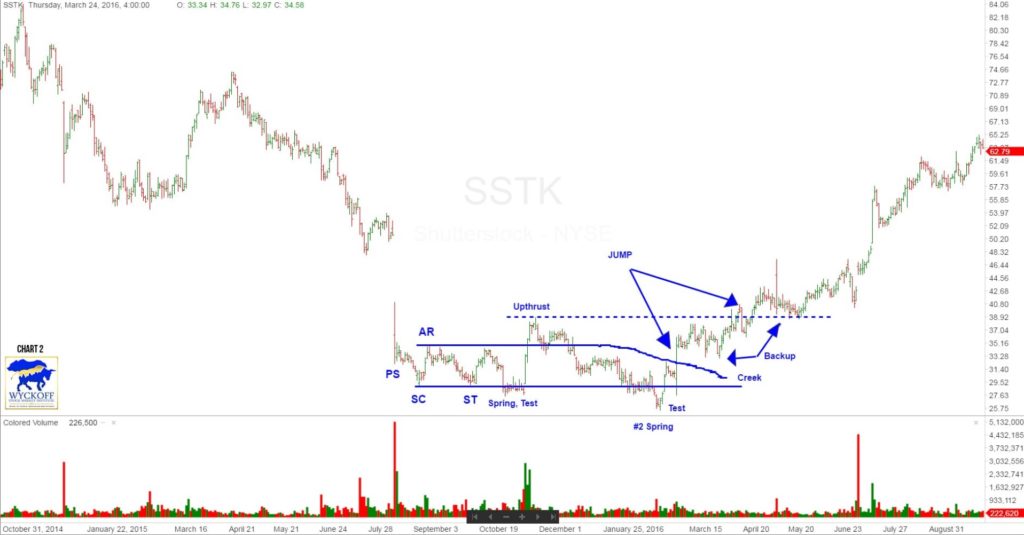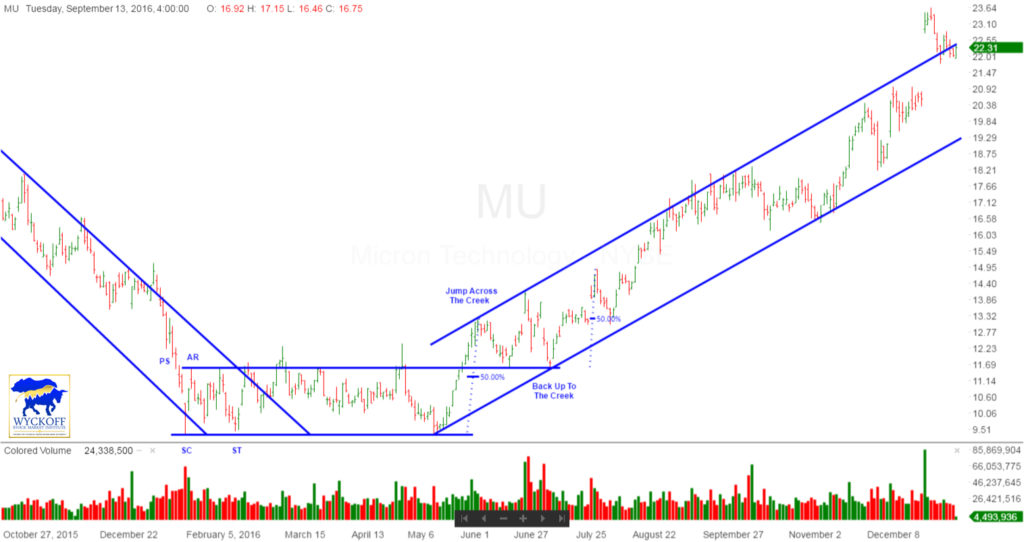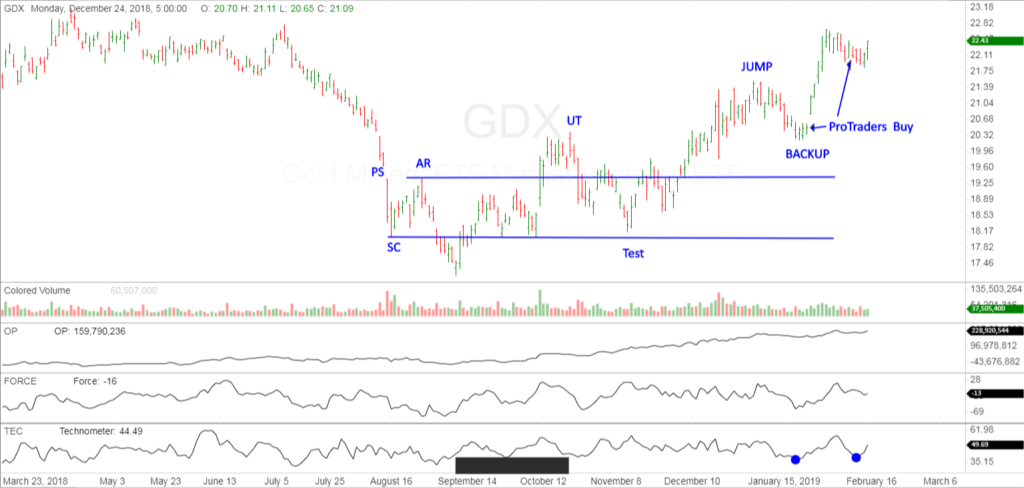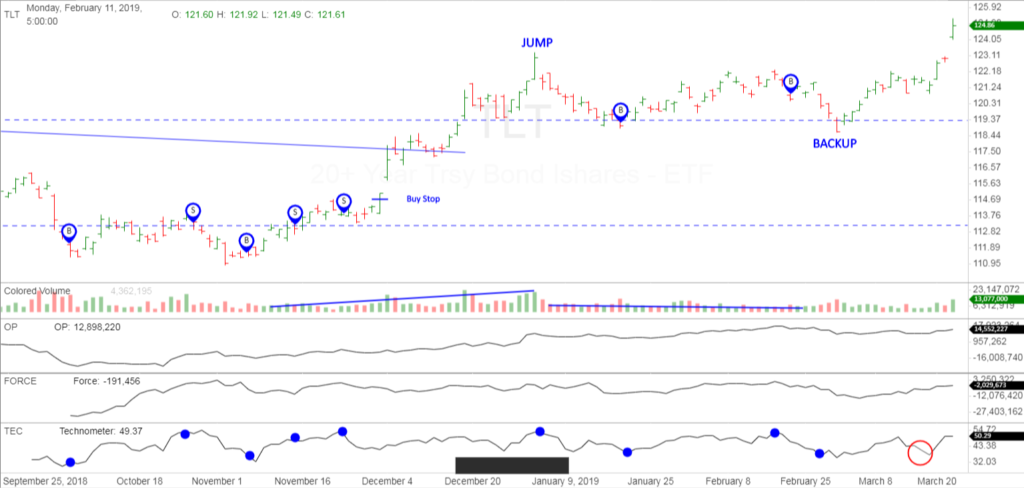If a Wyckoff trader chooses not to open a long position when the market or an individual issue is in a spring position and makes the same choice or misses the opportunity to enter on the long side on the test of a spring, there is a third primary buying opportunity that can be used to begin a campaign. It is on a back up to the edge of a creek.
A creek is the zone of resistance usually near the top of a trading range defined by a series of rally tops within the trading range. It represents an obstacle to up side progress that must be overcome if the price is going to work out the potential that has been built while the price has been in the trading range. The price overcomes the resistance with a sign of strength indicated by a combination of price spread and volume action.
There are three elements to the combination of price spread and volume action needed to accomplish a jump.
The first element is wide price spreads to the up side over several days as the price passes through the zone of resistance defined by the earlier rally tops.
The second element is strong closes on those days with the wide spreads. If the price makes a wide spread to the up side and then closes at or near the bottom of the spread, the indication is that supply was met and overcame the demand that entered the market and that the price is not ready to leave the trading range.
The third element is high volume. High volume confirms the sign of strength indicated by the price action. Most potential jumps will take the price through the resistance level of the trading range and decisively into new high ground relative to all the action that occurred during the trading range. However, some will not.
If the trading range is especially wide and most of the rally tops during the range are well below the resistance level, it is possible for a jump to be accomplished without moving the price up and out of the range. In those cases, the Wyckoff trader needs to recognize the fact that the resistance level of the range still represents an obstacle to up side progress that may derail the bullish scenario from unfolding as anticipated even though there was a jump and a back up. Some Wyckoff traders elect to avoid these situations due to the higher degree of doubt involved.
The completion of a jump is normally indicated by a dramatic narrowing of the price spreads to the up side following the wide spreads that moved the price through the zone of resistance. When this action occurs, the Wyckoff trader knows that the back up is about to begin and that it is time to start paying close attention to the day to day action so as not to miss the opportunity to take a position. When the back up begins, the trader needs to identify in advance where it is likely to be completed. It is impossible to pinpoint exactly at what level the back up is likely to be completed. The creek that was jumped was defined by a range of values and the area in which the back up is likely to be completed is defined by a range of values.
The first step in identifying where this range of values is located is to find the halfway point of the advance that produced the jump. Wyckoff tells us that it is normal for an advance to be corrected with a reaction to the vicinity of the halfway point of the advance. The halfway point is likely to be above the zone of values that represent the creek or in that zone. If the halfway point is above the creek, the back up is most likely to be completed between the halfway point and the top of the creek. If the halfway point is in the creek, the back up is most likely to be completed between the halfway point and the low point of the creek.
Those situations where the back up is likely to be completed above the top of the creek are the best. In those situations where the back up reenters the creek, there is a risk of the price falling back into the creek resulting in no buying opportunity.
Having an idea in advance where the price is likely to complete the back up is important. However, the most important factor on a back up is the character of the price and volume on the back up. If the back up unfolds with the same combination of wide spreads and high volumes that were present on the jump, there will be no opportunity to take a long position. In these cases, the price is most likely to fall back into the creek.
All that the potential jump accomplished was to suck in premature bulls and the bearish character of the back up tends to lock them into positions that probably will not be profitable. A bullish back up is indicated by narrowing spreads and decreasing volumes as the price reaches the pre-identified zone where the back is anticipated to end. This combination of where the price is and how it got there is what indicates to the Wyckoff trader that taking a position should be considered.
Taking a position on a back up is similar to buying the test a spring or a spring in one respect. Any position opened on a back up must be protected with a stop. Ideally, the potential up side objective will be high enough above the entry price to allow the initial stop to be placed below the support level of the trading range. The anticipated objective must be high enough above the entry price to allow the initial stop to be placed below the low point of the creek. Placing a stop so close to the entry price that it is in the creek is an invitation to be stopped out.
Theoretically, taking a long position on the back up to a creek where the jumping of the creek allowed the price to move up and out of a trading range is the best of all buying opportunities. This is because it provides the clearest indication that the preparation phase has been completed and that the price has the strength to overcome all obstacle to up side progress.





